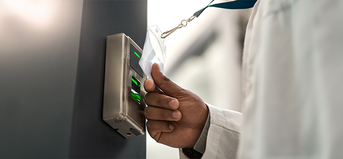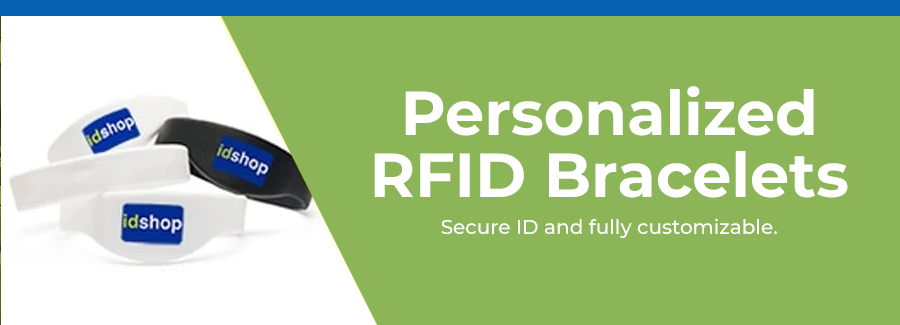ID Badge Security Features: 9 Essential Elements for Advanced Protection
ID badges serve multiple purposes, from identification to company branding — but one of the most essential features of badging is security. Whether monitoring access to an airport or health care facilities, or keeping track of employees and visitors in an office complex, your ID badge program is only as good as the security features you include.
This blog post will explore nine common methods for ensuring ID card security and highlight the features and applications of different badge security options.
High-Tech Badge Security
1. RFID Cards
Radio frequency identification, or RFID technology, relies on radio frequencies to communicate between an RFID-enabled card and its designated reader.
An RFID card is programmed with one or more specific codes. A corresponding reader is programmed to recognize these codes. Users can hold the RFID card up to the reader or walk nearby, and the reader will recognize that specific code and perform a predetermined action, like unlocking a door or logging someone in for their shift.
In the realm of security, RFID badges are useful for allowing entry to different parts of a facility based on the credentials stored in the badge.
Active RFID cards continuously transmit radio waves and can interact with readers up to 100 meters away. These are ideal for things like secure garage entry. Passive RFID cards are activated by their readers when they are within range. They have a shorter read distance than active and work well for secure door entry.
Overview:
- Radiofrequency communication for secure access
- Active cards for long-distance, passive for close-range
- Programmable for specific facility access
2. Smart Cards
Smart cards support advanced encryption standards (AES) and can store encryption data, obscuring personal information stored within the card. These ID cards cannot be cloned and offer a high level of security for high-risk facilities like government and financial institutions.
Contact smart cards require users to touch the chip to the card reader. Contactless cards use RFID technology to send and receive data within the range of the reader.
Overview:
- Advanced encryption for data protection
- Contact and contactless versions
- Ideal for high-security environments
3. RFID Blocking Badge Holders
RFID blocking badge holders ensure the data within your RFID security ID badge is protected and only used by the cardholder. The holders block electromagnetic data, preventing hackers from scanning or skimming the signal.
Overview:
- Blocks unauthorized scanning/skimming
- Prevents remote data capture
4. Proximity Cards
Proximity or prox cards work similarly to RFID but require users to be within a few centimeters of the reader. The low-frequency (125 kHz) contactless credentials are read-only and most commonly used in locations where quick, contactless entry is needed, such as office buildings.
While prox cards require you to be close to a reader, they are contactless and can streamline entry over a swipeable card.
Overview:
- Close-range contactless entry
- Read-only
- Ideal for quick entry in offices, etc.
Visual Security and ID Badge Design
5. Photo ID
Including employee or visitor photos on ID badges is an easy way to ensure the person matches the badge. It’s not foolproof, but photos can up your level of security, especially when combined with other security features.
Overview:
- Visual identity verification
- Easy implementation, minimum security
6. Holograms
Holographic overlays add another layer of visual security to your ID badges. Whether embedded into the card or placed on top, they are hard to copy and offer a level of badge protection above photo identification. As an added bonus, holographic overlays make cards more durable by adding a layer of protection.
Most major badge printers offer overlaminate ribbons to make hologram printing easy. You can also purchase holographic sticker labels to apply to badges after printing.
Overview:
- Difficult to replicate
- Adds to card durability
- Available in overlays and stickers
7. Self-Expiring Badges and Stickers
Self-expiring badges offer a practical and cost-effective way to enhance security for temporary visitors to your site. These badges change color or display a visible sign that the badge has expired after a set period. Self-expiring badges or stickers are ideal for hospital visitors and temporary contractors. They do not require special technology, and can be printed and applied on-site.
- Visibly indicate expired access
- Easy to use on-site
- Ideal for temporary access control
Additional ID Security Features
8. Barcodes
Simple, effective and widely used, barcodes are an easy way to secure data in ID cards. Whether a series of lines read by an optical scanner or a QR code, these codes can store a wide range of information, from basic identification to more complex data. Barcodes offer minimal security when used alone but can be one part of a more robust badge security program.
Overview:
- Simple, versatile data storage
- Minimal security
- Barcode or QR codes
9. Magnetic Stripe
Swipe cards feature a magnetic layer encoded with data, which can be read by swiping the card through a magnetic reader. Magnetic stripes can store more data than barcodes and are ideal for time tracking, clocking in and out and access control to certain secure areas instead of prox or RFID cards.
Overview:
- Stores more data than barcodes
- Swipe reader for access
- Ideal for time tracking, secure area access
The Right ID Security for You
These security features are often combined, depending on your needs and capabilities. Consider the following when deciding which security features to implement to your ID badge program:
- Access control needs. Do you have restricted areas within your facility? How many employees or visitors need access to these areas? Barcodes, magnetic stripes, prox, and RFID technology can all help you manage access depending on the level of security you need.
- Security level. High-risk environments like hospitals, financial institutions or airports require the higher level of security found in RFID or smart cards.
- Existing infrastructure. A new secure card system requires more than the badges. Barcodes, magnetic strips and RFID cards rely on supporting technology like card readers and software to process the data. Upgrading to a new technology will require an upfront financial investment.
- Employee and visitor experience. When considering a new badge program, gauge the response from employees and visitors. Many security solutions improve the overall user experience of things like clocking in and out and accessing restricted areas.
- Growth potential. Make sure to choose solutions that can grow with your organization. Consider features that can be easily updated and added to as your needs change.



